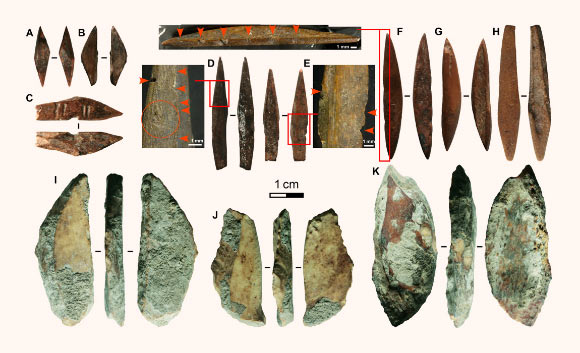Archaeologists have found over a hundred bone arrow points at the Pleistocene cave site of Fa-Hien Lena in Sri Lanka. The artifacts were used to hunt tree-dwelling animals such as small monkeys and squirrels about 48,000 years ago and represent the earliest known bow-and-arrow technology outside of Africa.
Source: Sci News
“The island of Sri Lanka in the Indian Ocean, just south of the Indian subcontinent, is home to the earliest fossils of Homo sapiens in South Asia,” said lead author Dr. Michelle Langley of Griffith University and colleagues from Australia, Germany, Sri Lanka, Canada, and the United States.
“It also preserves clear evidence for human occupation and the use of tropical rainforest environments outside of Africa from 48,000 to 3,000 years ago, refuting the idea that these supposedly resource-poor environments acted as barriers for migrating Pleistocene humans.”
“The question as to exactly how humans obtained rainforest resources, including fast-moving food sources like monkeys and squirrels, remains unresolved.”
At the Fa-Hien Lena cave site in southwestern Sri Lanka, the researchers unearthed a total of 130 projectile points carved from bone which are about 48,000 years old.
“The size, form, and damage found on many of the bone points were best explained by their having been used as arrow tips to hunt difficult-to-catch rainforest prey, rather than spears,” Dr. Langley said.
“The fractures on the points indicated damage through high-powered impact — something usually seen in bow-and-arrow hunting of animals.”
Bone tools and the animals from which they were produced at the Fa-Hien Lena site. Image credit: Langley et al, doi: 10.1126/sciadv.aba3831.
The team also found a range of other bone and tooth tools, including scraping and piercing tools suitable for making nets or working skins or plant fibers in the tropical setting.
“Evidence for the construction of nets is extremely scarce in artifacts many thousands of years old, making this aspect of the Fa-Hien Lena assemblage a startling find,” Dr. Langley said.
“We also found clear evidence for the production of colored beads from the bright red, yellow, and metallic silver mineral ochre found in the cave and the refined making of shell beads traded from the coast.”
“Fa-Hien Lena has emerged as one of South Asia’s most important archaeological sites since the 1980s, preserving the remains of our species, their tools, and their prey in a tropical context,” said co-author Dr. Oshan Wedage, a scientist at the Max Planck Institute for the Science of Human History and the University of Sri Jayewardenepura.
“Together, these artifacts reveal a rich human culture in the tropics of South Asia which was creating and utilizing complex hunting and social technologies to not only survive, but thrive, in demanding rainforest environments,” added co-author Dr. Patrick Roberts, a researcher at the University of Queensland.
“These findings provide some of the first detailed insights into how our species met the extreme adaptive challenges it encountered across tropical Asia during global human expansion,” said co-author Professor Michael Petraglia, a scientist at the Max Planck Institute for the Science of Human History, the University of Queensland, and the Smithsonian Institution’s National Museum of Natural History.
“They show how resilient and creative Homo sapiens has been in expanding its territories and encountering the new flora and fauna of foreign lands.”
The discovery is described in a paper in the journal Science Advances.
Source: Sci News

































Leave a Comment
You must be logged in to post a comment.